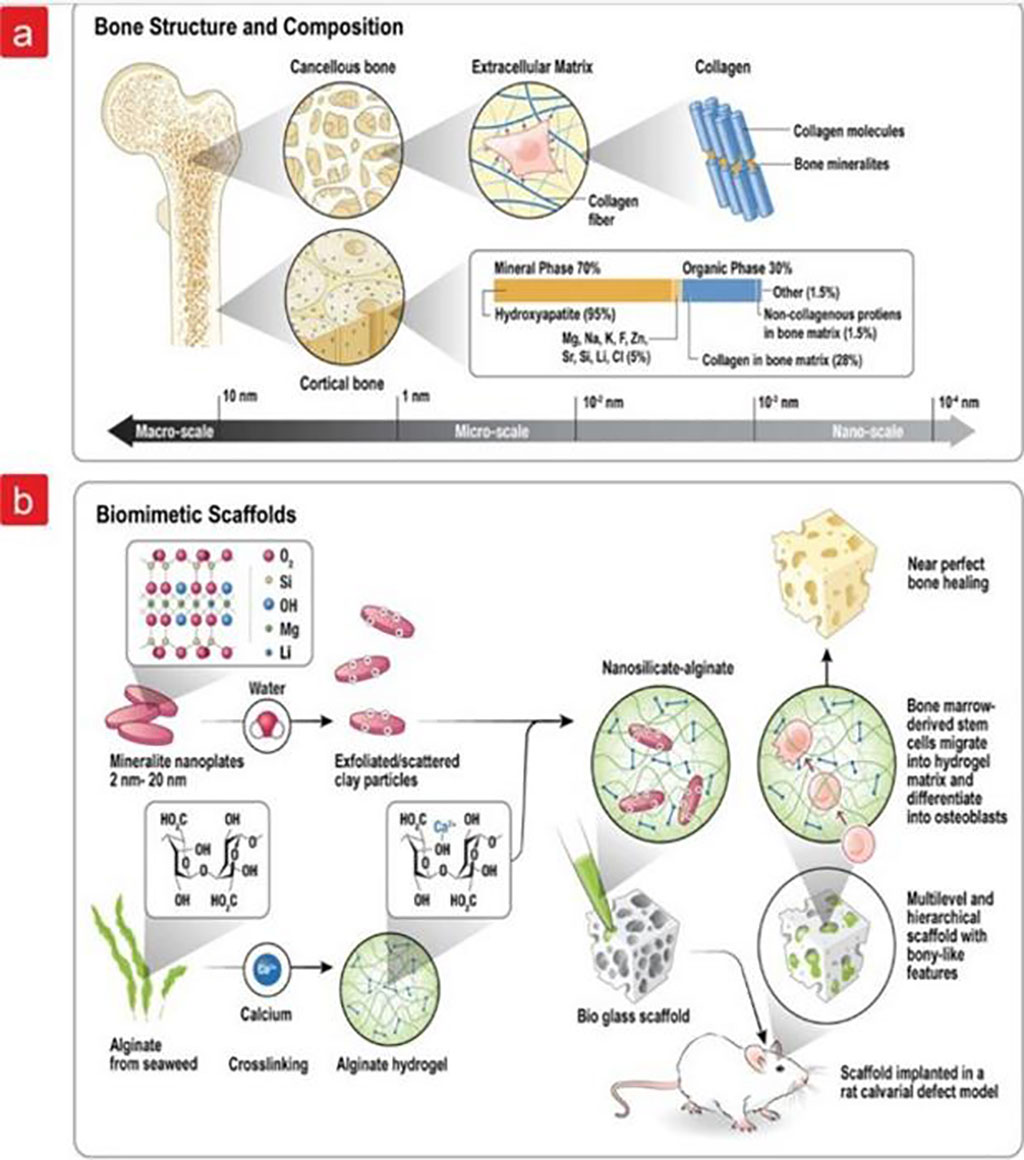Quick Healing Bone Scaffold Could Be a Game-Changer in Tissue Regeneration
|
By HospiMedica International staff writers Posted on 28 Jun 2023 |

Bone tissue loss, which can result from trauma, osteoporosis, and metastatic bone diseases, impacts 20 million individuals globally every year, making bone the second most frequently transplanted tissue. Established techniques such as autografting, allografting, and xenografting are commonly used, yet they pose challenges like infection risk and rejection that impede their clinical applications. Bone tissue engineering, a method that combines scaffolds, hydrogels, and occasionally stem cells to create bone tissue, is a potential solution. Despite its potential, the technique still hasn't reached its full capabilities, mainly due to the lack of biomaterial systems that accurately replicate native bone complexity.
Now, researchers at Technical University of Denmark (DTU, Kongens Lyngby, Denmark) have advanced tissue regeneration by developing a multi-leveled scaffold that replicates the properties of native bone on nano, micro, and macro scales. In their study, they observed near-complete bone healing in a rat model within eight weeks using their scaffold, without the need for growth factors. Additionally, the scaffold is combinatorial, capable of releasing several essential bone minerals while meeting the mechanical properties required to match the compressive strength of human cancellous bone. The team is now aiming to reduce the healing time to four weeks and achieve near-immediate tissue regeneration without using endocrine factors and cells and is also investigating potential applications for other tissues.
This research has huge implications. By incorporating stem cells, bioactive components like collagen and gelatin, coatings that encourage native cell migration into the scaffolds, and electromagnetic stimulation, this could potentially accelerate the healing process for soldiers with severe musculoskeletal fractures or civilians with traumatic injuries. These individuals typically face months of hospitalization and a lengthy recovery. Notably, the newly developed scaffold is primarily composed of glass, alginate, and nano silicate, materials already approved by the FDA. This approval significantly reduces regulatory obstacles, allowing the scaffold to be confidently and efficiently used in clinical settings, thereby expediting development and improving patient outcomes.
"I believe this discovery could be a game-changer in the field of tissue regeneration, and I hope to see this technology being used to help those in need," said Associate Professor Alireza Dolatshahi-Pirouz who led the research team at DTU Health Tech.
Related Links:
Technical University of Denmark
Latest Surgical Techniques News
- New Transcatheter Valve Found Safe and Effective for Treating Aortic Regurgitation
- Minimally Invasive Valve Repair Reduces Hospitalizations in Severe Tricuspid Regurgitation Patients
- Tiny Robotic Tools Powered by Magnetic Fields to Enable Minimally Invasive Brain Surgery
- Magnetic Tweezers Make Robotic Surgery Safer and More Precise
- AI-Powered Surgical Planning Tool Improves Pre-Op Planning
- Novel Sensing System Restores Missing Sense of Touch in Minimally Invasive Surgery
- Headset-Based AR Navigation System Improves EVD Placement
- Higher Electrode Density Improves Epilepsy Surgery by Pinpointing Where Seizures Begin
- Open-Source Tool Optimizes Placement of Visual Brain Implants
- Easy-To-Apply Gel Could Prevent Formation of Post-Surgical Abdominal Adhesions
- Groundbreaking Leadless Pacemaker to Prevent Invasive Surgeries for Children
- Spectroscopy Technique Improves Surgery for Pediatric Epilepsy Patients
- Bioengineered Arteries Show Promise for Cardiovascular Surgery
- Online Tool Guides Surgical Decisions for Gallbladder Cancer
- Innovative Technology Enables Rapid Life-Saving Surgical Leak Detection
- First-Of-Its-Kind Bioresorbable Implant to Help Children with Rare Respiratory Disease
Channels
Critical Care
view channel
Mass Manufactured Nanoparticles to Deliver Cancer Drugs Directly to Tumors
Polymer-coated nanoparticles loaded with therapeutic drugs hold significant potential for treating cancers, including ovarian cancer. These particles can be precisely directed to tumors, delivering their... Read more
World’s Smallest Pacemaker Fits Inside Syringe Tip
After heart surgery, many patients require temporary pacemakers either to regulate the heart rate while waiting for a permanent pacemaker or to support normal heart rhythm during recovery.... Read more
AI-Powered, Internet-Connected Medical Devices to Revolutionize Healthcare, Finds Study
A new study suggests that artificial intelligence (AI)-powered, internet-connected medical devices have the potential to transform healthcare by enabling earlier detection of diseases, real-time patient... Read morePatient Care
view channel
Portable Biosensor Platform to Reduce Hospital-Acquired Infections
Approximately 4 million patients in the European Union acquire healthcare-associated infections (HAIs) or nosocomial infections each year, with around 37,000 deaths directly resulting from these infections,... Read moreFirst-Of-Its-Kind Portable Germicidal Light Technology Disinfects High-Touch Clinical Surfaces in Seconds
Reducing healthcare-acquired infections (HAIs) remains a pressing issue within global healthcare systems. In the United States alone, 1.7 million patients contract HAIs annually, leading to approximately... Read more
Surgical Capacity Optimization Solution Helps Hospitals Boost OR Utilization
An innovative solution has the capability to transform surgical capacity utilization by targeting the root cause of surgical block time inefficiencies. Fujitsu Limited’s (Tokyo, Japan) Surgical Capacity... Read more
Game-Changing Innovation in Surgical Instrument Sterilization Significantly Improves OR Throughput
A groundbreaking innovation enables hospitals to significantly improve instrument processing time and throughput in operating rooms (ORs) and sterile processing departments. Turbett Surgical, Inc.... Read moreHealth IT
view channel
Printable Molecule-Selective Nanoparticles Enable Mass Production of Wearable Biosensors
The future of medicine is likely to focus on the personalization of healthcare—understanding exactly what an individual requires and delivering the appropriate combination of nutrients, metabolites, and... Read more
Smartwatches Could Detect Congestive Heart Failure
Diagnosing congestive heart failure (CHF) typically requires expensive and time-consuming imaging techniques like echocardiography, also known as cardiac ultrasound. Previously, detecting CHF by analyzing... Read morePoint of Care
view channel
Handheld, Sound-Based Diagnostic System Delivers Bedside Blood Test Results in An Hour
Patients who go to a doctor for a blood test often have to contend with a needle and syringe, followed by a long wait—sometimes hours or even days—for lab results. Scientists have been working hard to... Read moreBusiness
view channel
Expanded Collaboration to Transform OR Technology Through AI and Automation
The expansion of an existing collaboration between three leading companies aims to develop artificial intelligence (AI)-driven solutions for smart operating rooms with sophisticated monitoring and automation.... Read more

















